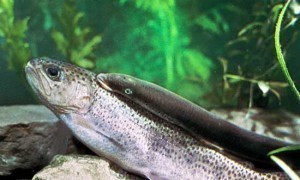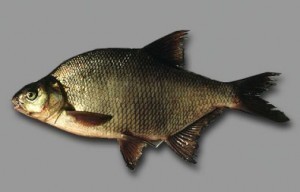Size of a Lamprey
Lampreys are sometimes referred to as Lamprey Eels, but this is  actually a misnomer. While bearing a resemblance to eels, they are in actuality parasitic marine animals of the Petromyzontidae family. Adults of the species range in size somewhere in the region of 13-100 cm (5-40 in), significantly smaller than an eel’s maximum length of 3.75 m (12.3 ft).
actually a misnomer. While bearing a resemblance to eels, they are in actuality parasitic marine animals of the Petromyzontidae family. Adults of the species range in size somewhere in the region of 13-100 cm (5-40 in), significantly smaller than an eel’s maximum length of 3.75 m (12.3 ft).
Also referred to as the Wide-mouthed lamprey, Geotria australis or the Pouched lamprey is the lone species in the Geotriinae subfamily’s single genus Geotria. Common in the Southern Hemisphere, particularly in southwestern and southeastern areas of Australia, New Zealand, Argentina and Chile, the pouched lamprey has a length of 60 cm.
From the genus Mordacia of the subfamily Mordaciinae, Mordacia mordax or the Short-headed Lamprey, is also found in southeast Australia. As such, it is also dubbed the Australian lamprey, as well as the Murray lamprey. It can grow up to a length of 50 cm. Mordacia praecox is a non-parasitic freshwater lamprey species that is likewise endemic to southeast Australia, and measures approximately 12-15 cm.
Belonging to the genus Ichthyomyzon, the Northern Brook lamprey or Ichthyomyzon fossor is native to North America and has an average size of roughly 15 cm (5.9 in). Also part of the same genus, the Silver lamprey’s binomial name, Ichthyomyzon unicuspis, is literally Greek for “fish to suck” and Latin for “one point.” Usually found in North and Central America, as well as a large portion of southern Canada, this species is known to reach an adult size of 36-38 cm (14-15 in).
A species of the genus Lampetra, the European River lamprey (binomial name: Lampetra fluviatilis) is common to most of Europe’s coastal waters, specifically the rivers of the Alps and the lakes of Finland, Norway, Russia, Scotland and Wales. Its average adult length is 30 cm, though some adults come in at a smaller size of 20 cm. Their life span is measured as being around 10 years.
Lampetra planeri, the European Brook lamprey, is widespread in the European area of the Atlantic Ocean and the northwest area of the Mediterranean Sea, as well as the waters of continental Europe. Physically similar to the European river lamprey, the European brook lamprey is distinctly smaller in size, an adult of the species averaging 12-14 cm in length.
Still part of the genus Lampetra, the Pacific lamprey or Lampetra tridentate makes its home in the Pacific coastal waters of Asia and North America. It can grow up to around 76 cm long (30 in). Petromyzon marinus or the Sea lamprey is the single species of the genus Petromyzon. Located in the Atlantic coastal waters of North America and Europe, the western part of the Mediterranean, and the Great Lakes of North America, it can grow up to a length of 90 cm (35.5 in).
Lampreys are not to be considered part of the fish family, of which true eels are members of. Some species in fact attach themselves to and suck blood from other fish. In this regard, they are actually more akin to leeches than eels. Indeed, their name can be literally translated as “stone lickers,” taken from the Latin words lambere (“to lick”) and petra (“stone”).





